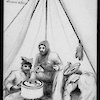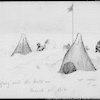Autumn reconnaissance
In their own words
Six of us set out to lay a depot and had a very rough time. Wild who has had more experience of the Antarctic than any man living told me it was the roughest he ever experienced.
— Dovers, letter to Ula, 25 April 1912
On this first journey, men were to haul the two sledges; the dogs were not up to the task after their long sea voyage. Accompanying Wild were George Dovers, Evan Jones, Charles Harrisson, Morton Moyes and Charles Hoadley, leaving behind Alexander Kennedy and Andrew Watson to keep operations going at the hut.
At 7am they struck out in a south-easterly direction. In 10 hours of careful marching they covered 12 kilometres. Next day, despite soft snow and a heavily undulating surface near where the ice shelf joined land ice, they managed over 21 kilometres, but the much sought-after ice shelf remained ahead, always seeming closer than it really was.
It was not without its dangers. Crevasses, as always, were the main concern: ‘Hoadley went down to his head in one, and we all got our legs in others,’ wrote Wild. One of them, covered by a snow bridge, was over 15 metres wide; they crossed it gingerly, one by one, supported by ropes. By the end of the third day, they had reached the line of the coast, 50 kilometres from their home base, and another five days of intermittent marching took them well up on to the plateau, nearly 500 metres above sea level and 100 kilometres from the Hut.
They camped in a depression in the icecap, but a heavy snowfall followed by a high wind and flying snow kept them tent-bound. The blizzard imprisoned them in ‘Satan’s Hollow’, as they called it, for eight long, irksome days. It spanned the same days as another blizzard — the one that effectively ended the lives of Robert Scott and his party, snowbound in their tent on Ross Ice Shelf, 3000 kilometres away across the continent.
Having decided that further progress southward was impossible, Wild laid a food depot and turned anxiously to the homeward journey. The first day’s ‘march’ was a nightmare of undulating, soft snow in which the men covered only two kilometres. The first few days were a similar slog, but it got steadily better after that.
By 4 April, after walking 36 kilometres that day, they estimated they were close to the Grottoes, but could find no sign of it. All next day they were confined to their tent by a raging blizzard. On 6 April they packed up and set off — to find the Grottoes, almost hidden by snow, only three kilometres away.



